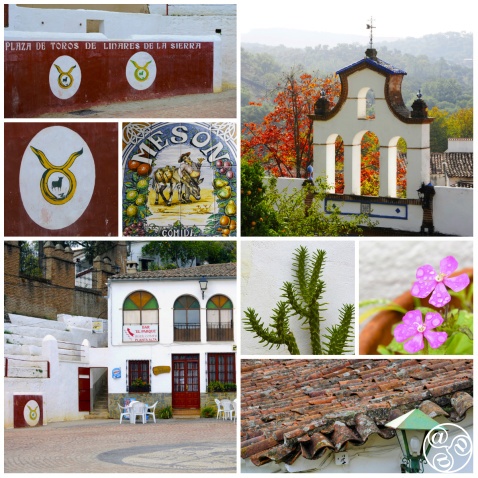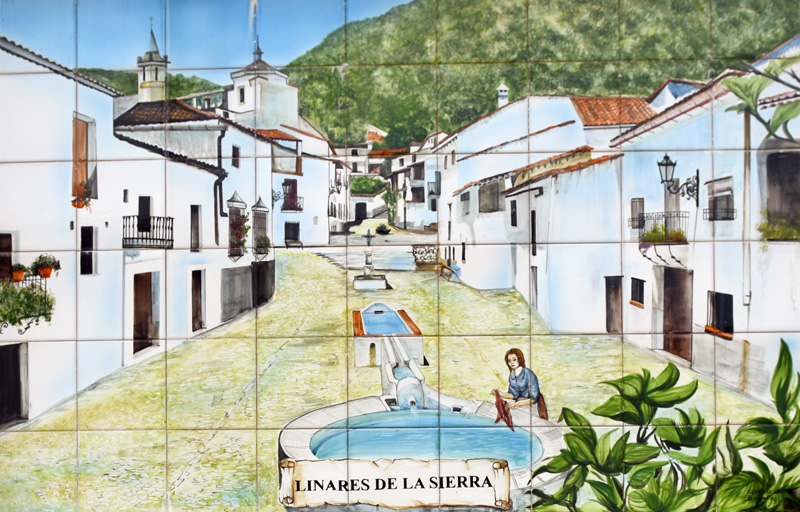
Linares de la Sierra |
|
Linares de la Sierra
This quaint village is located a short drive from the local main town of Aracena, and has steep, cobbled streets.
The village, with a population of 300, lies at 500m above sea level, and has been declared of cultural interest by the regional government. It is a very medieval-looking village, built on the side of a steep hill, without many public spaces. In the winter, grass grows between the cobbles and makes the streets look like a green carpet.
Linares lies within a pretty wooded valley of evergreen oak and holm oak, acorn and chestnut trees of the valley of the Arroyo Plamencia in the Parque Natural Sierra de Aracena y Picos de Aroche In the village and its vicinity acequias (irrigation channels) remain from Moorish times.
HISTORY
The village is of Moorish origin and later came under Portuguese control until passing to Castille under the council of Seville in the 13th century. In 1640 Aracena and the villages around became part of the domain of the Conde-Duque de Olivares. This later passed to the 'Principado de Aracena' as part of the 'Condado de Altamira'. Linares de la Sierra separated from Aracena in 1754 by royal order of Fernando IV. After this the population grew and the village became important enough to build the large church seen today. At that time the population was over 1,000 and thriving on fruit farming. In the 19th century many migrated to the mines in Rio Tinto and again in the 1960s. The miners' strike of Rio Tinto as depicted in the 2007 film El Corazon de la Sierra (the Heart of the Mountains) was filmed in Linares.
THINGS TO SEE
Lavadero público
Located in the Plaza de la Fuente (from Calle Real, turn down Calle San Juan, and then take the steps on the right-hand side). The public washing fountain and trough has three parts: the first, the fountain with four chutes, feeds via an underground pipe, the rectangular water trough for animals and along an open overflow channel to the circular clothes washing section. Perfectly designed to accommodate 18 stone washboards in a small space; ideal for the Linares señoras to gossip. The fountain never stops flowing and the water continues from the lavadero via three different channels to irrigate the orchards. The original construction date is not known but it is at least two centuries old. The present fountain element is dated 1908 and a plaque credits its donation to the village by the then-mayor.
Iglesia de San Juan Bautista
Huelva architect José Alvarez probably designed the large parish church in popular baroque, classical baroque and a touch of neoclassical style in the 18th century and it was dedicated to San Juan Bautista (Saint John the Baptist).
The main square (old bullring)
The main village square is round-shaped because it used to be the bullring - grandstand seating can be clearly seen. These days it is used for cultural presentation rather than bullfights. The dusty albero (sand) in the centre has been replaced by cobbles, so you can stop by the square and have a drink in one of the bars. A tourist information room has panels with local information. Look out for the 500-year-old oak tree called 'El Alcornoque Torero' that grows awkwardly sideways from the seating area. A plaque in the square bears a poem dedicated to it.
La Plaza de Colón or Plaza Juan Ramón Jiménez is next to the Iglesia de San Juan Bautista above the bullring. Plaza de la Fuente (formerly Plaza Calvo Sotelo) is where the lavadero is located. There is also Plaza Juan de Dios Pareja Obregón.
Los Llanos
'Carpets' or mosaics made of cobbled stones in designs of motifs, flowers, animals are is a popular sierra style and can be seen in the entrance to many village houses or in the squares. Los Llanos is also a nickname for the village.
Village fountains
Fuente de la Plaza de la Iglesia is a modern (1984) construction supplied by mains water. Fuente del Parque is a more recent construction. Fuente Vieja (old fountain) is located at the lower outskirts of the village. Judging by the steep track to Fuente Vieja the villagers must have celebrated when Fuente Nueva (new fountain that supplies the lavadero) was constructed. Fuente de Andalucía is relatively new and water brought from a spring 1km away.
THINGS TO DO
Hammam La Molinilla
Visit the Arab baths for a relaxing bathe or massage.
Parking and orientation
The country road HU-8105 from Aracena bypasses the village on the top side and is called Avenida de Andalucia. You can park here and walk down into the square. Alternatively enter by Calle Real and park near the village map. From here walk past 'El Rincon de Lorenzo bar' and follow Calle Real towards the church and main square.
Hotels in or near Linares de la Sierra
Book Hotels in or near Linares de la Sierra
COUNTRYSIDE WALK
There are a number of walks in the vicinity but one of the best is the 3.8-km signed path from Linares de La Sierra to Alajar an easy one and a half hours. The path follows the stream uphill, climbing back to the country road at El Puerto de Linares. Over the watershed it drops down following a tributary of the Riviera de Alajar
A circular route can be completed by returning via the abandoned hamlet of Los Madroñeros as described by Guy Hunter Watts as "The walk of the forgotten Hamlet"
HANDICRAFTS
Local handicrafts are wooden ítems and baskets made from olive tree branches.
RESTAURANTS
Meson Arrieros is an unexpectedly sophisticated restaurant for such a small, isolated village, cited in the New York Times, The Times of London and the Michelin Spain and Portugal Guide. More >
GASTRONOMY
Local gastronomy is all manner of pork dishes. A local dessert is the famous piñonate, also ajo batanero, puchero de matanza, tapiales, gazpacho de invierno, ensalada de patatas, tomato soup, migas serranas, guiso viudo or and picadillo chicharrero. Desserts are orejones, peras a lo pobre, poleás y potage de castañas.
FESTIVALS
Three Kings
This event on 5th January takes place all over Andalucia but in Linares it is particularly important. Bonfires are lit in the streets to keep everyone warm, stalls sell hot drinks and snacks. Rather than a formal procession, the villagers open their front doors and set up makeshift belenes vivientes (living nativity scenes) and up to 1,000 visitors come to the village to see. Watch the video.
Cabalgata de Higuera de la Sierra
The Cabalgata de Reyes de Higuera de la Sierra is the second oldest in Spain and classified as a Festival of Tourist Interest in Andalusia. More >
Independence Day
On the nearest Saturday to 7 March the town hall organises a free puchero (stew), accompanied by typical fiesta activities such as singing and dancing.
Easter Sunday (Domingo de Resurrección) is the Fiesta del Piñonate, when the local desert is celebrated.
Romeria de San Juan
On the last Saturday in May, early in the morning, the villagers carry the Simpecado from the parish church to a place in the woods called Agua de la Paloma where the christening of the new pilgrims is carried out. The procession continues to Vallezorras where a mass is celebrated, followed by a traditional paella, offered to all pilgrims present
Feria San Juan
On 24 June a three day-feria takes place in honour of San Juan Bautista. Main venue is Plaza de Juan de Dios Pareja Obregón.
Night of the Poets
The festival has been celebrated on the last Saturday in June since 2000. Poems are read in the village at night by literary celebrities and children, usually in Plaza de la Fuente.
LOCATION
Linares de la Sierra is 100km from Huelva Capital; from the A-49 Autopista del Quinto Centenario turn off onto the A-435 in the direction of Valverde del Camino and then take the N-433 to Aracena, From Seville head north on the E-833 Ruta de la Plata and take the N-433 towards Aracena. From Aracena take the country road HU-8105 to Linares de la Sierra. You can make a circular tour by continuing on to next villages Alajar and then Fuenteheridos or Santa Ana la Real.
